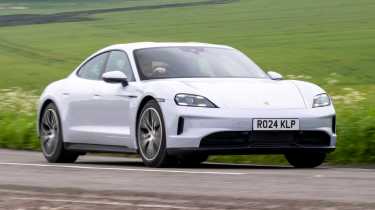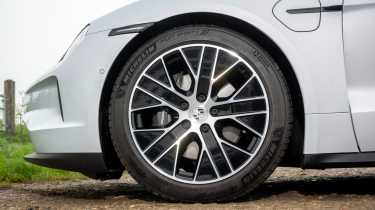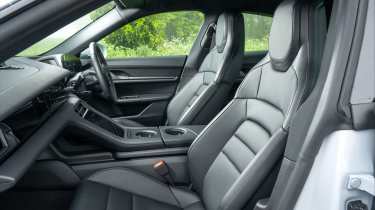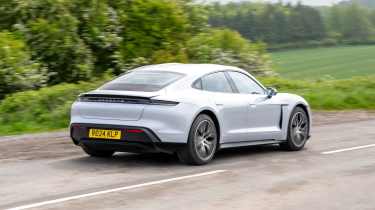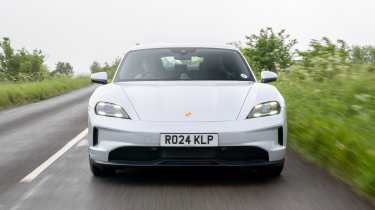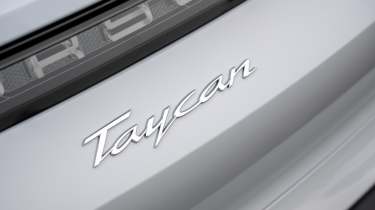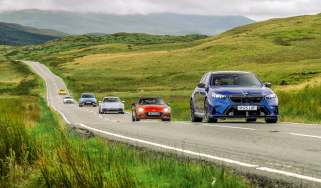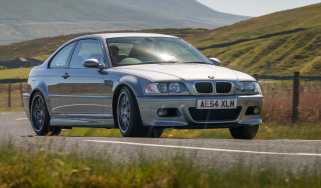Porsche Taycan RWD 2025 review – a good car at good price, but mind that depreciation
The best real-world Taycan got an update in line with the rest of the lineup. It remains a great car that’s now more usable than ever
Time once was that if someone actually asked you which Taycan to get (if any), the default recommendation was to go for the cheapest rear-drive car that also quietly offered the most range and, if you had Turbo S money, buy a 997 Carrera S with the spare change.
But with its mid-life update, most of the Taycan range has matured into a car much closer to what Porsche promised it would be from the start – an all-rounder with the range and usability to match its performance, dynamics and presence. This obviously means the base RWD car has been updated too. Now the Taycan’s all grown up, is the cheapest, longest-legged car still the best and more to the point, is it worth doing Porsche a solid, risking the depreciation and actually buying one?
You might be thinking 'no' given current market headwinds and the pivot the industry is set to take, slowing the rush to all electric offerings. But at £88,200 starting, it’s around £12k less than a basic 911 and £1000 cheaper than a basic Panamera. There is an argument here that this is a better value proposition than ever before, depreciation potential accepted... The design still impresses too – it turns heads and people certainly still think it's a more expensive car than it is.
Motor, gearbox and technical highlights
Unlike in the old car, Performance Battery Plus is a box you can’t untick in the configurator at the time of writing (September 2025) though it was a paid option at launch in 2024, costing £4454. This means among other things that your standard Taycan has 429bhp and 310lb ft, and can cover 417 miles (WLTP) on a full charge courtesy of its 97kWh battery.
More reviews
In-depth reviews
Review
Reviews
> What on Earth is this Porsche prototype? Taycan ‘GT4 RS’ spied testing
These are huge improvements over the last-generation car, of 55bhp and 116 miles. It’s quicker, getting to 62mph in 4.8sec (down from 5.4sec) and can get to 143mph flat-out. The new car is also a hair lighter at 2170kg – no life changing reduction but a drop all the same, largely thanks to the Taycan’s revised battery. That also informs improved charging speeds – up to 320kW that can be delivered near-instantly at the right charger, where the old cars did need a ramp-up to full speed. Some even say there’s no need to pre-condition the battery anymore.
Porsche’s intention with the Taycan wasn’t to create a more sporting, purist version of its four-door EV, but rather to just create a fully realised rear-drive version that didn’t feel in any way compromised. Suspension is retuned but only to account for the weight differences and to ensure that traction remains a strong point even without the driven front wheels.
Where air springs with PASM dampers were once an option, it’s now the default set-up across the range. The ultra-expensive, ultra-trick Porsche Active Ride hydraulic suspension system is now the major upgrade. Non-standard too is rear-steering (£1592), the lack of which was curious to experience on the relatively basic (for a press car) example we had. It didn’t even have the Porsche Torque Vectoring limited-slip differential (£1157). Ceramic brakes are an option omitted on our car too at £7230.
The key to this base Taycan though is to keep things simple and miss a lot of this stuff if you can help it. With the kinds of deals your local Porsche centre will be happy to discuss, a Taycan with a few choice touches for under £90k is something approximating good value, if you’re not thinking too much about the potential depreciation…
> Electric Porsche Cayman and Boxster spied: 600bhp sports car gears up for launch
The Taycan retains the 4S model’s two-speed transmission and rear-mounted motor and by losing the front motor there’s a weight saving of around 100kg. Obviously the potential of the Taycan can be spun a number of ways… the most intriguing of which is a rear-motored, rear-wheel drive sports saloon with nearly 500bhp, that produces maximum torque instantly and has the option of a limited slip differential. I know what you’re thinking. It just needs a hydraulic handbrake and the steering lock of a London cab…
Driving the Porsche Taycan
The reality is of course different. Despite the switch to rear-drive the Taycan remains pretty true to the character we’ve already experienced in 4S, Turbo and Turbo S models: supreme competence, shocking control for such a heavy car and a polish to all the controls and the damping that is signature Porsche.
No, it isn’t some giant EV drift Porsche that’s determined to silently assassinate tyres. But in this new more potent form, it is now quite quick, unlike the original base Taycan. That instant torque snatches at the rear wheels with more vigour, needing much less deliberate intention to breach traction than before. If it’s wet, this car does require throttle input management from a standstill and accelerating away with any sort of steering angle and purposeful throttle input loads the car with the rear-driven tension of a more traditional sports saloon. The PTV+ diff was a shoo in from the options list before and that doesn’t change but if it was an option you’d spec to add a bit of life to the last car, it’s to add a bit of control and sophistication to this new car.
When it’s dry and when you develop a flow, the refinement of the package, impeccable body control and pure mechanical grip that the Taycan boasts means you can make swift, effortless progress and enjoy the balance of the car to a point. This is much closer to the sweet-spot Taycan we had envisaged before driving the first RWD car.
The way this big saloon snicks into corners; the flat, stable platform that seems impervious to body roll in Sport and Sport Plus modes and the undramatic but persistent performance means you can fly across the ground without seeming to expend any effort at all. Only the strong smell of brakes wafting into the high-quality interior betrays the battle of physics going on at ground level. They work well enough but the pedal feel is inconsistent when you really start flinging the Taycan around. An Achilles heel of the Taycan before that’s not healed with this revised car.
It could do with being a bit more engaging, too. The steering is sharp (requiring acclimatisation for the purposes of direction management at speed) and more talkative than all the other AWD J1 platform cars, but it’s lacking the last four tenths of real dialogue. Likewise in spite of the great balance and control the Taycan commendably exhibits, plus the rear-lead throttle adjustability that’s heightened with the extra power, the weight meets you right at the eight-tenth point to remind you not to get ideas above the Taycan’s station. It’s good but like a lot of big, heavy fast family cars of late, whether electric or hybrid, there’s about 700kg sat between you and the magical super saloon experience we all miss. Not to mention a boot where the V8 should be in this case.
Would we spec the rear-steering then? For the sake of improving the driving dynamics, no. It’d gain supernatural agility, yet there’s something to be said for a simpler feel. For the sake of making the base Taycan what it wants to be, which is a usable, tractable every day car? Yes. You could even skip the LSD to make up the cost difference – blasphemy, we know.
Then, you’ll have a well-made, handsome, quick-charging all-round performer that’ll cover well over 300 miles in almost all road driving without protest, at an appropriate price. Porsche’s claims around the charging hold up too. Plug in to a quick enough charger and you almost won’t have time for a lap of a supermarket before your pre-payment is sent into the battery.
It’s a good car made better, the new Taycan. Just so long as you can stand the infuriating climate control ergonomics. Nevermind a pain, having to select a point on a diagram of the car’s dash on the screen to choose where the blowers point is borderline unacceptable. Ho hum. The basic seats are comfortable, if not supportive. It’s as easy and relaxing to waft around in as it ever was, as impractical too – that boot aperture isn’t the largest even if there’s decent space and the rear of the cabin is a squeeze for adults.
Price and rivals
The base Taycan is now priced from £88,200, up from the £70,790 the original launched at in 2021. Everything’s gone up though and that extra cash does now get the big battery and the air suspension as standard. Arguably, this is the best value Taycan there’s ever been.
The Tesla Model S was the car at which the Taycan was ostensibly aimed but in 2025, you can’t order one new in the UK. So you must look immediately to the new Audi e-tron GT Quattro, which is priced from £88,555. It’s more powerful – over 490bhp – and has AWD, though it doesn’t deliver the same range – 300 miles is realistic but takes less abuse than in the Taycan to slip under.
There are fresh rivals to consider too – the Lotus Emeya 600 and the new Polestar 5 Long Range are here to muscle in on the svelte EV saloon market (what’s left of it at least), the latter sporting over 700bhp and similar range for £89,500, the former with 600bhp and 379 miles of range for £84,990. The Lotus has a much more special-feeling cabin and really solid dynamics, while the Polestar adds serious kerbside spaceship appeal to its comparatively blistering performance. For some, only a Porsche will do, for which we’re in no position to ascribe blame. Feeling brave? There’s always one of the many last-gen cars with tiny miles for close to half price…
Internal combustion alternatives are numerous, though you won't get more than a turbocharged V6 in a base Panamera for base Taycan money, or rather £1k more. Likewise it's closer in price to the £76k 550e xDrive BMW 5-series than it is the £111k M5. The AMG GT Four Door is off sale now and will soon be replaced by an all-electric successor with advanced electric powertrain tech previewed in the Concept AMG GT XX.
